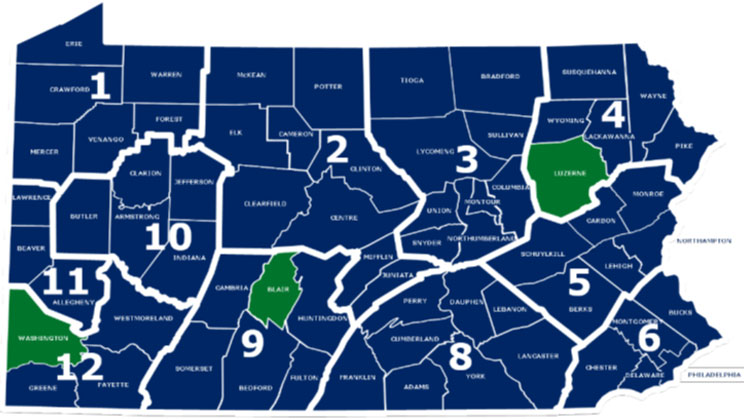
Pilot Project Locations
| Name of Agency | Pennsylvania Department of Transportation (PennDOT) |
|---|---|
| Location | Statewide |
| Project Delivery Method | Design-Bid-Build (D-B-B) |
| Procurement Method | Low Bid |
| Total Project Cost | 2012 Pilot Project
Year 1: District 6
Year 2: District 11
Current funding is $3 million per year |
| Funding Source | 100% State-Funded |
| Construction Schedule | Design and construction less than 18 months total. |
| Project Description | This project started as a pilot in 2012. Bundled bridge projects are confined to one district, preference to one county, within a 15-mile radius. All bridges must be in poor condition and locally owned, with preference given to structures that are posted or closed. PennDOT targeted single-span bridges between 20 feet and 60 feet in length with skews less than 15 degrees. To maximize efficiency in design and construction, only bridges with very similar details are chosen. The goal is to have one design for all structures in the bundle and to replace multiple bridges of varying length with one bridge of a standard length. Lengthening a structure in this case is appropriate, as well as eliminating skew. If there are more than three designs per bundle, the bundle may not generate the level of savings desired to make the program viable (refer to enclosed flow chart that shows the selection process). Bridge bundles can be as large as desired, but individual contracts should be developed in groups of 7-10 structures to optimize construction crews. PennDOT has documented significant savings in design and construction from using this method. They have saved up to 50% on design cost and up to 15% on construction cost when compared with traditional one-bridge projects. Due to the savings, the normal 5% local public agency (LPA) contribution to the project is waived. Participation in the program is voluntary, but it is a popular program due to the fact that the LPAs have no contribution. Because these bridges are locally owned, the LPA signs an agreement that transfers ownership of the bridge to PennDOT for the design and construction of the bridge. Once the project is completed, the bridge ownership is transferred back to the LPA. Due to its success, the local bridge bundling program has continued to be funded beyond the pilot phase. It is currently funded at $3 million per year. |
| Project Website | None |
| Program Goals | To save time and money by increasing efficiency by re-using similar design details on bridges in the bundle. |
|---|---|
| Bridge Selection Criteria |
|
| Delivery and Procurement Method | D-B-B, Low Bid |
| Funding Sources, Financing Strategy | 100% State-Funded. No local match. |
| Environmental, Right-of-Way, and Utility Considerations | Sites with limited third party coordination to streamline efficiency. |
| Risks |
Similar risk to traditional project. |
| Owner Management/Quality Assurance | D-B-B, so QA/QC is the same as a traditional project. |
| Stakeholder Communication |
Coordinate with local public agencies during the bridge selection process. Communication with stakeholders during design is similar to a traditional project. |